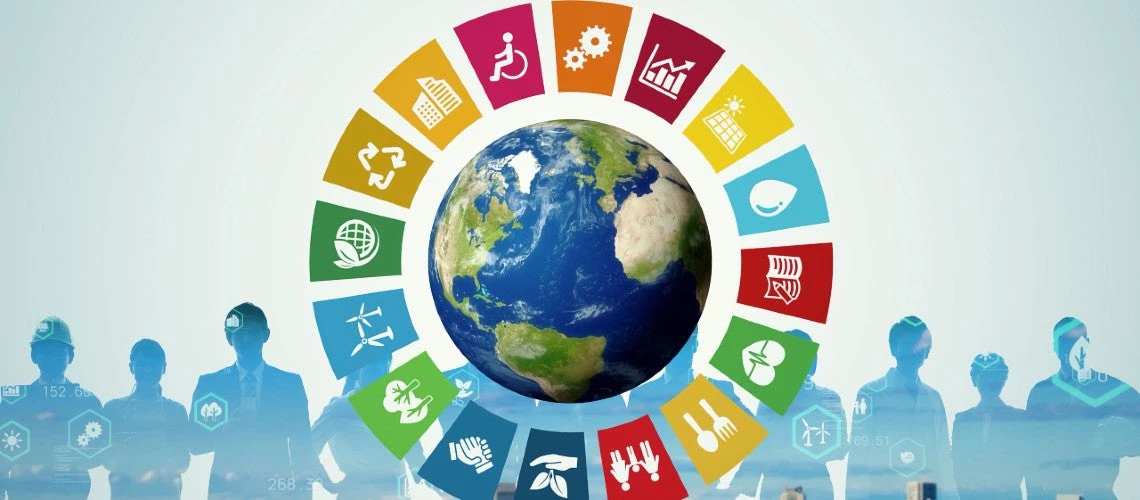 A group of people standing amidst a graphic of the sustainable development goals
A group of people standing amidst a graphic of the sustainable development goals
After a rough summer with intense temperatures, raging fires, and floods, widespread eco-anxiety, or chronic fear of environmental doom is setting in. As the world is increasingly suffering from climate-change induced angst, these realities are changing the lens through which the utility of public-private partnerships (PPPs) is being examined.
The need for public-private sector collaboration
The trifecta of black swan events over the last three years—the global COVID-19 pandemic, natural disasters, and geopolitical events—has destabilized economies. As a result, governments are forced to seek alternative sustainable and resilient development mechanisms to bridge the funding gaps for infrastructure and services that are needed for countries to achieve their Sustainable Development Goals (SDGs). While there is some cynicism and skepticism on the role the private sector can play with the public sector to fill development gaps, there is an increasing awareness among governments that they cannot go it alone and need to work with the private sector.
From PPPs to People-First PPPs
These dynamics have not gone unnoticed by PPP project proponents and practitioners who have called for a change in how PPPs are implemented. Increasingly, PPP procurements are looking for factors that include value for money and value for the future. Woven into the current debate on the purpose of PPPs is the aspiration that PPPs address sustainability and resilience, gender inequality, and climate change. This paradigm shift positions PPPs as more than a sterile traditional procurement mechanism, but rather as a proactive and innovative approach to deliver projects that can help countries achieve their SDGs.
Through its PPP Center of Excellence, the United Nations Economic Commission for Europe (UNECE) has introduced an innovative concept PPP approach, the “People-first Public-Private Partnerships” (PfPPPs), which is built on guiding principles that define PPPs as having the following five outcomes: access and equity, economic effectiveness and fiscal sustainability, replicability, environmental sustainability and resilience, and stakeholder engagement. To help PPP practitioners screen projects for these five outcomes, an evaluation methodology has been prepared that consists of:
- Benchmarks and indicators that demonstrate achievement in each of the five PfPPP outcomes
- A weighting and ranking of these outcomes along with other issues pertinent to scoring
- A scoring system to help governments and other partners revise and adjust projects to make them more compliant with the PfPPP outcomes and the SDGs
The clarion call for people-centric PPPs is also being addressed by the World Bank and its CP3P (Certified Public-Private Partnerships Professional) partners who are currently revising sections to include a greater emphasis on climate change and gender equity. It is hoped that this review will further spur on the development of PfPPP projects that address the needs of marginalized groups such as women.
PPPs as a sustainable and resilient agent for disaster mitigation
The recent massively destructive natural events such as the fires in Maui, Hawaii, the earthquake in Morocco, and the flash floods in Derna, Libya, will provide greater recovery opportunities to procure projects reliant on PPP paradigms that ensure projects are built back better (future-proofed), engage stakeholders, and are people-centric. This will require PfPPPs to include resilience considerations that include robustness, redundancy, resourcefulness, and recovery rapidity. There is also an increasing role for PPPs in post-conflict situations, such as in Ukraine, where both public and private sector resources will have to be collaboratively mobilized to rebuild war-ravaged communities.
These goals will require further exploration of sustainable and resilient approaches to implement PfPPP disaster-recovery project strategies that are sensitive to the needs of traumatized communities—whether they are suffering from eco-angst or post-conflict stress. Rather than procuring a project quickly without much thought for future needs, this is the time for governments to ensure that projects serve a greater development purpose that withstand the test of time through a changing climate.
Disclaimer: The content of this blog does not necessarily reflect the views of the World Bank Group, its Board of Executive Directors, staff, or the governments it represents. The World Bank Group does not guarantee the accuracy of the data, findings, or analysis in this post.
Related Posts
Introducing the sector-specific climate toolkits for infrastructure PPPs
A short history of PPPs for development: the good, the bad, and the hopeful
A new tool for boosting SDG investment through PPPs
SDGs and PPPs: What's the connection?


Join the Conversation